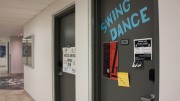Exhibitionists might just decide to fly more often, following an announcement by the federal government on Jan. 5, 2010, that, in order to increase security at Canadian airports, full body scanners would be pressed into service in eight cities across Canada, including Winnipeg.
First used by London England’s Heathrow airport in 2005, full body scanners have since been installed at several airports in many different countries, most notably in the U.S. and Europe.
How they work
The devices, which can see through clothing to detect concealed weapons and other contraband, use one of two technologies to develop an image of the person being scanned.
Backscatter X-ray devices were the kind first deployed in the UK, and work by bombarding the individual being scanned with extremely low intensity x-rays. The image is created by sensors, which detect the X-rays as they bounce off of the individual’s skin.
Different materials reflect X-rays differently, in proportion to their density, allowing the machines to differentiate between skin, clothing and objects such as guns. Furthermore, objects containing low atomic number elements — atomic number reflects the number of protons an element has in its nucleus — such as oxygen, carbon, nitrogen and hydrogen can be highlighted by a backscatter X-ray machine, a very useful feature since these elements are common in explosives.
The second kind of machine uses milimetre wave (MMW) radio frequency beams to generate an image. The radio waves, which have a wavelength of 1000 times smaller than those used for FM radio, are tuned to move through clothing and bounce off of human skin especially well, and provide a 3D image of the person being scanned. Anomalies appearing in the scan, such as weapons or explosives, are outlined against the individual’s skin.
MMW scanners produce a lower resolution image than backscatter x-ray machines, however MMW scanners are much faster, taking between 15 and 30 seconds to complete a scan, as opposed to more than 60 for the backscatter machine.
In terms of danger to the person being scanned, both L-3 Communications and American Science and Engineering, the companies that produce the MMW and backscatter scanners, respectively, claim that being scanned exposes the user to less than 1/10,000th the amount of radiation from a typical cell phone call, or the equivalent of spending two minutes in an airplane at cruising altitude (9,150 m).
Privacy and usefulness
Although backscatter X-ray scanners were the first to reach the market, MMW scanners have since become the technology of choice for many governments, including Canada, mainly because they can produce an image four times faster than backscatter machines, despite the lower resolution of the image produced.
In fact, the lack of sharp detail in the MMW scan has been touted as an advantage to the system, as many people and privacy advocacy groups have take issue with the scanners, and the images they produce.
Barry Steinhardt of the ACLU’s technology and liberty project told the website Livescience.com, “Body scanners produce graphic images of travelers bodies, and are an assault on their essential dignity.” This can be especially true for individuals who have undergone medical procedures, such as colostomies, mastectomies and have devices such as catheters and penile implants, all of which show up clearly on a MMW or backscatter image.
In an effort to curb concern about the scanners and personal privacy, airports in the U.S. mandate that the scanner’s operator is housed in a remote location, and never sees the individual directly. Furthermore, the machines do not have the ability to save an image, and software that blurs the individual’s genitalia and face is employed. Scans are also currently only carried out on individuals selected for additional screening, and can be declined if the individual consents to a pat down.
Both kinds of scanners can also be augmented with software, which replaces the individual’s image with an outline, as opposed to the detailed 3D image typically displayed. However, according to a report on the Global News website, the Canadian government has decided to buy scanners which do not have these software upgrades, as they feel that the act of blurring parts of an individuals body to the operator, or reducing their form to an outline, defeats the purpose of the scanner.
And therein lies one of the problems with these full body scanners; in order for the scanners to be effective at countering all threats, an operator needs to see the individual as clearly as possible. Regardless of whether blurring software is used though, according to Steinhardt, the machines amount to “nothing more than an electronic strip search.”
Adding to the controversy regarding the privacy-invading nature of these machines is the fact that, during a trial held in Kelowna, B.C., between 2008 and 2009, operators reported that while L-3 Communications advertises that as many as 600 passengers can be screened in an hour, the most they were able to process was 61.
At a cost of $200,000 per machine, not including the price of installation or the operator’s salary, one has to wonder — given their limited ability, slow operation and violations to personal privacy — if these machines are really the answer to keeping air travelers safe.
According to an article appearing on the technology blog Gizmodo.com, you are 20 times more likely to be struck by lightning than die on an airplane as the result of terrorism. And while it would be foolish to ignore any threat to air safety, maybe the real question should be, why isn’t the government doing more to protect us from lightning?




